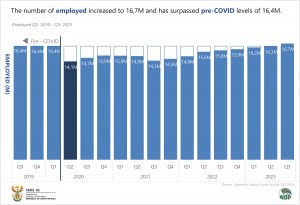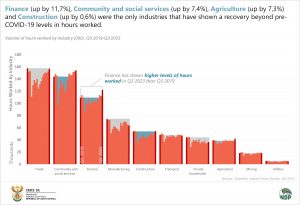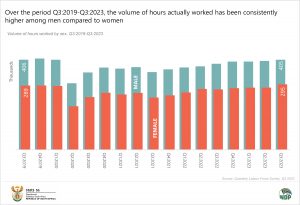Employment surpasses pre-COVID levels in SA
Millions of people’s livelihoods, jobs, and health were in jeopardy because of the health crisis caused by COVID-19. The global economic crisis that emerged was a result of the impact of COVID-19. The impact of the pandemic and the related containment measures led to a severe contraction in economic activity as many people were unable to go to work or search for work; and businesses could no longer operate. South Africa was no different, with the number of employed persons decreasing by over 2,2 million in the second quarter of 2020. In line with international standards, the Quarterly Labour Force Survey (QLFS) defines employed persons as those aged 15–64 years who, during the reference week, did any work for at least one hour, or had a job or business but were not at work (i.e. were temporarily absent).
The years 2021 and 2022 saw the relaxation of COVID restrictions around the world and in the country. Businesses started to move to normality and to hire again. This is reflected in the fourth quarter of 2021, where employment levels started to increase. Since then, employment has shown a positive trend, with the largest change being recorded in the second quarter of 2022.
Before the COVID-19 pandemic, employment levels were recorded at 16,4 million in the first quarter of 2020. During the pandemic, employment levels reached 14,1 million. According to the Quarterly Labour Force Survey for the third quarter of 2023, the number of employed persons increased by 399 000 to 16,7 million, as compared to the second quarter of 2023. This is the eighth consecutive increase in employment since Q4:2021 and the first to surpass the pre-COVID employment levels of 16,4 million. Not only have employment levels shown improvement in the labour market, the volume of actual hours worked have also improved drastically post-COVID.
Measuring the number of hours worked is an essential economic indicator. Despite being in employment, numerous workers had to decrease their working hours due to the repercussions of the COVID-19 pandemic, while many others faced job losses. According to the QLFS, total hours worked in the first quarter of 2020 were 1,1% less than in the fourth quarter of 2019 due to the COVID-19 pandemic. There was a significant drop of 28,5% in the number of hours worked between Q1:2020 and Q2:2020, equivalent to 2,2 million job losses. All industries showed a decrease in the number of hours worked, with the highest declines in total hours worked per week in private households (36,8%), Construction (36,6%), Community and social services (33,3%), and Mining (30,5%).
Since Q4:2021, actual hours worked have seen a significant recovery. Total number of hours actually worked per week have, so far, exceeded pre-COVID-19 levels by 0,8% between Q3:2019 and Q3:2023. Finance (up by 11,7%), Community and social services (up by 7,4%), Agriculture (up by 7,3%) and Construction (up by 0,6%) were the only industries that have shown a recovery beyond pre-COVID-19 levels in hours worked.
Over the period Q3:2019-Q3:2023, the volume of hours actually worked has been consistently higher among men compared to women, signifying that women are once again the hardest hit.
For more information, download the full report here.




